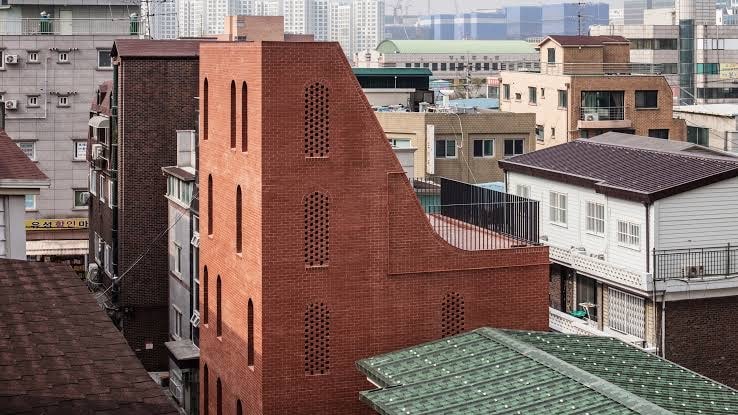Approximately 90% of that land is mountainous, meaning that the Koreans have had to use space ingeniously to make room for everybody. This means mostly building up instead of out.
While there are a few single-family houses dotted around the landscape, there are three main types of living quarters that South Korea’s expats will find themselves living in. Read on to see what your future house in South Korea will probably be like.
By far, the most popular type of housing in South Korea is the apartment, and Koreans see the “apatu” much like Westerners see the single-family house with white picket fence and private lawn. For this reason, there has been a housing boom in South Korea as speculators build more and more apartment blocks, and prices were not hit by the 2008 crash that devastated the housing stock in countries like America.
For this reason, renting apartments in Korea can be expensive. In a middle-class area in Seoul, the monthly rent for an apartment can easily top 1 million won (850 USD) for an old building in pretty rough condition. New apartments are kitted out with state-of-the-art appliances you probably didn’t even know existed (I’ve seen shoe closets that automatically disinfect shoes with ultraviolet light). You’ll pay a premium for these units, which may cost over 2 million won, and even above 3 million in a sought-after neighborhood. Prices will be slightly lower in Busan, but the real deals are in the countryside, where new, ultra-modern three-bedroom apartments can be rented for less than 500,000 won.
Those prices don’t include the high housing deposits in South Korea, which I’ll discuss in a future post. For apartments, expect to put down at least 10 million won. Deposits of 100 million won are possible, if you want to live amongst Korean celebrities and moguls.
Apartments tend to be two or three-bedroom units, and are built largely for families. Since many Koreans live with their parents until they marry, and married couples tend to have children shortly after tying the knot, there is less demand for smaller apartments for couples in the country. The one-bedroom apatu is a rare breed.
Apartments are usually stacked above one another in identical blocks that can be found throughout the country. One development will consist of several massive concrete buildings that are identical to each other and facing one another in a small community. There is usually a small shop and maybe a restaurant or two on site, but most apartment-dwellers will go to a nearby boulevard for shopping, entertainment, and nightlife.
Officetels
A great example of Konglish, “officetel” is a portmanteu of “office” and “hotel”, but many units in these buildings are neither. Designed to be used either as a workplace or a residence, many units in officetels are inhabited by single people who want a place to live close to their workplace. For this reason, a lot of officetels are studios, although larger units are available, but they tend to be quite expensive. For a studio, expect to pay between 600,000 and 800,000 won per month in Seoul. In the trendy neighborhoods of Apgujeong, Gangnam, and Cheongdam-dong, officetels can be much pricier, but deals can still be found.
Unlike the concrete apartments, officetels are often glass-and-steel affairs, with shiny facades that look sleek and ultra-modern. Also unlike apartments, they usually have a number of restaurants and shops in their bottom floors. If you live in the right building, it’s possible to buy groceries, go to the gym, watch a movie, and have a few drinks at a bar without once stepping outside.
Like apartments, officetels command a large deposit of 5 million or 10 million won.
The Koreans took the term “villa” from Latin, but the buildings have little in common with their Roman namesakes. In Korea, villas are a fast-disappearing type of urban housing that have been unpopular amongst the Koreans for decades. Several tower cranes dot the landscape of Seoul, Busan, and other Korean cities where shiny new apartment complexes are being built over what was once a sprawling neighborhood of tightly-connected villas.
The Korean villa usually stands no more than four stories tall and doesn’t have an elevator. Many are made out of red brick, but more recent builds tend to be made out of granite. Villas are particularly common in Itaewon and Noksapyeong, the area in central Seoul where a large part of the expat community, including English teachers, diplomats, and U.S. military personnel, choose to live. As such, a number of expats striking out on their own may find themselves living in a villa in the area.
Because of the cramped neighborhoods and limited view, villas tend to have smaller windows than apartments, although most will have a huge floor-to-ceiling window and balcony connected to the living room. Villas usually consist of eight to ten apartments on four stories and are sometimes connected to neighboring villas, or they will have a small sliver of space between buildings. A number of “rooftop” apartments have been built on the top floor of villas, and these are usually the cheapest residences you can get in Korea, even though they often have spectacular views and a private or semi-private rooftop terrace to enjoy in warmer months.
Because they are less popular, villas tend to cost less than officetels or apartments, despite offering more space. The cheapest one-bedroom villa in Noksapyeong will cost about 400,000 won. Two bedrooms in the city will cost about the same as a studio officetel–around 600,000 to 800,000 won per month, with Gangnam, Apgujeong, and Cheongdam-dong again being much more expensive.
Besides being more spacious, villas are also much cheaper. Three-bedroom units can easily be found for less than a million won. Some even require smaller deposits, sometimes as low as 2 or 3 million won.
Source: aetnainternational.com





